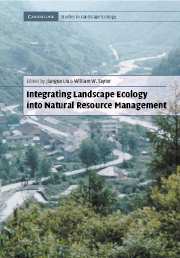Book contents
- Frontmatter
- Contents
- List of contributors
- Foreword
- Preface
- Acknowledgments
- PART I Introduction and concepts
- PART II Landscape structure and multi-scale management
- PART III Landscape function and cross-boundary management
- PART IV Landscape change and adaptive management
- PART V Landscape integrity and integrated management
- PART VI Syntheses and perspectives
- Index
- Plate Section
PART V - Landscape integrity and integrated management
Published online by Cambridge University Press: 14 January 2010
- Frontmatter
- Contents
- List of contributors
- Foreword
- Preface
- Acknowledgments
- PART I Introduction and concepts
- PART II Landscape structure and multi-scale management
- PART III Landscape function and cross-boundary management
- PART IV Landscape change and adaptive management
- PART V Landscape integrity and integrated management
- PART VI Syntheses and perspectives
- Index
- Plate Section
Summary
Parts II through IV of this book emphasize three separate aspects of landscape ecology (landscape structure, landscape function, and landscape change in structure and function) and their corresponding management paradigms (multi-scale management, cross-boundary management, and adaptive management). While separate aspects of landscape research and management paradigms are important, an integrated approach to study and manage landscape integrity is urgently needed. By landscape integrity, we mean overall measures of landscape health status. Although landscape integrity is a relatively unexplored subject, we believe that it can be measured by indicators, such as productivity and diversity of native species. As landscape integrity may result from the interactions between landscape structure and function, and it may vary with the dynamics of landscape structure and function, the management of landscape integrity requires an integrated approach incorporating multi-scale, cross-boundary, and adaptive management. It is essential that different types of management are balanced for different objectives and coordinated by integrating both spatial and temporal dimensions of landscapes. Integrated management considers landscape structure, function, and change simultaneously, and accounts for multiple resources at the same time. Because a landscape consists of multiple resources (e.g., forest, wildlife, land, water), considering only single resources will likely change the balance among various resources and thus result in imbalance or loss of landscape integrity. Furthermore, many resources depend on each other. For example, many wildlife species (e.g., birds) help trees in pollen transfer and seed dispersal. On the other hand, many trees provide wildlife species with food and shelter. The four chapters in Part V address various important issues related to landscape integrity and integrated management.
- Type
- Chapter
- Information
- Integrating Landscape Ecology into Natural Resource Management , pp. 347 - 348Publisher: Cambridge University PressPrint publication year: 2002



